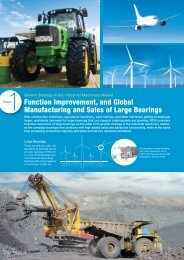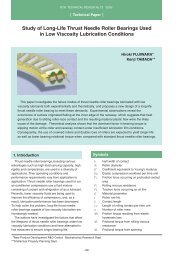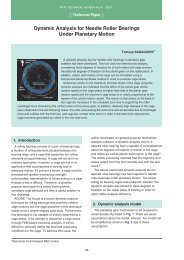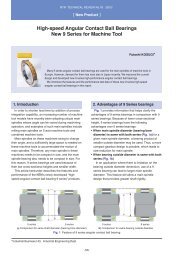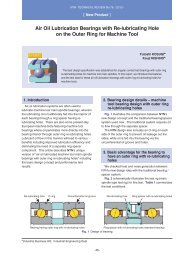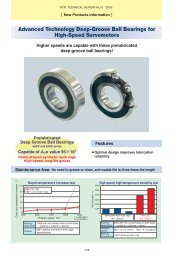Special Issue; Products for Industrial Machinery - NTN
Special Issue; Products for Industrial Machinery - NTN
Special Issue; Products for Industrial Machinery - NTN
Create successful ePaper yourself
Turn your PDF publications into a flip-book with our unique Google optimized e-Paper software.
<strong>NTN</strong> TECHNICAL REVIEW No.742006<br />
hobbing. Recently, a main spindle mounted to an area<br />
equivalent to a turret is capable of not only auxiliary<br />
cutting processes, such as end milling, but also to<br />
more demanding milling processes. In addition, lathebased<br />
machine tools that resemble milling machines<br />
have been developed. One example of such a<br />
combined machine tool is shown in Fig. 3 (Mori Seiki<br />
Co. NT5400DCG).<br />
Table 2 Background, supporting technologies and<br />
advantages of combined multi-functional machine tools<br />
Simultaneous 5-axis control machining center<br />
(e.g.: three orthogonal axes and two rotational axes)<br />
Combined machining turning center<br />
(e.g.: lathe and 2nd main spindle, B axis, Y axis, etc.)<br />
(Background, supporting technologies)<br />
¡Need <strong>for</strong> high-precision, high-efficiency machining to make<br />
more advanced (complicated) parts and components<br />
¡Increased sophistication of supporting software (CAM)<br />
¡Development of high-precision, high-efficiency machine<br />
elements (e.g.: DD-motor driven tables, etc.)<br />
(Advantages)<br />
¡Improved machining accuracy, reduction in machining time<br />
(one-chuck process)<br />
¡Machining of complicated shapes<br />
Presence/absence of<br />
workpiece transfer<br />
Polishing<br />
Slope machining<br />
(drilling)<br />
Hobbing<br />
Slope machining<br />
(milling)<br />
External circumference<br />
machining (turning)<br />
External circumference<br />
80 machining (milling)<br />
60<br />
External circumference<br />
machining (thread cutting)<br />
40<br />
External circumference<br />
machining (drilling)s<br />
20<br />
0<br />
End face machining<br />
(drilling)<br />
End face machining<br />
(milling)<br />
Bore machining<br />
(turning)<br />
Bore machining<br />
(thread cutting)<br />
Bore machining<br />
(milling)<br />
End face machining<br />
(turning)<br />
Fig. 2 Survey of machining examples by combined multi-axis<br />
machine tools based on turning machines<br />
Many different 5-axis machining centers have been<br />
developed. In particular, in addition to orthogonal 3-<br />
axis vertical and horizontal machining centers, many<br />
simultaneous 5-axis control machining center products<br />
that have work tables with two additional axes <strong>for</strong><br />
rotation and oscillation are used widely. Most recently,<br />
some machining centers have a work table driven by a<br />
DD motor and a high-speed, high-power rotary table<br />
capable of high-speed indexing, and they feature the<br />
functions of vertical turning centers. As mentioned<br />
above, deriving from either lathes or milling machines,<br />
combined multifunctional machining tools may evolve<br />
into novel machine tools that incorporate features of<br />
both turning centers and milling machines.<br />
Combined multifunctional machine tools have<br />
advantages that include the following. They are<br />
capable of machining complex <strong>for</strong>ms that require<br />
simultaneous control of five axes. Loss in machining<br />
accuracy from dismounting and remounting the<br />
workpiece is prevented because once a workpiece<br />
has been mounted to the chuck, all machining<br />
processes are executed without need <strong>for</strong> rechucking<br />
the workpiece. As the needs <strong>for</strong> function-intensive<br />
parts and components increase, advanced combined<br />
multifunctional machine tools are capable of<br />
machining these workpieces at higher precision and<br />
higher efficiency. As superior machine tools, the<br />
demand <strong>for</strong> combined multifunctional machine tools<br />
will increase further in the future. To meet this<br />
demand, the researchers and engineers in this field<br />
must develop the hardware that helps realize<br />
sophisticated functions as well as the supporting<br />
software (CAM) to enable advanced control<br />
techniques and application technology.<br />
Incidentally, within the next 2 years, the STC-M<br />
(Scientific Technical Committee: Machines) of CIRP<br />
(The International Academy <strong>for</strong> Production<br />
Engineering) will issue a keynote paper that covers<br />
current and future trends in combined multifunctional<br />
machine tool technology.<br />
Fig. 3 An example of combined multi-axis machine tool (Mori Seiki Co. NT5400DCG)<br />
-4-


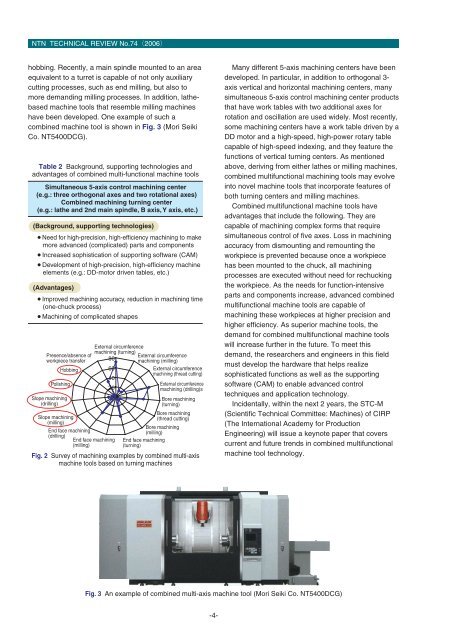
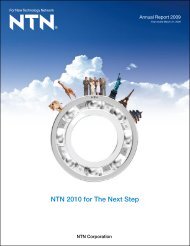
![[New Product] Unit Products for Office Equipment - NTN](https://img.yumpu.com/27154451/1/184x260/new-product-unit-products-for-office-equipment-ntn.jpg?quality=85)
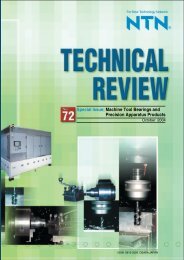
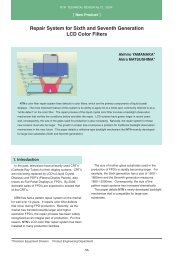
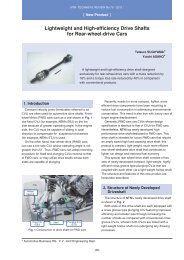
![[New Product] Development of Oil-impregnated Sintered ... - NTN](https://img.yumpu.com/27154427/1/184x260/new-product-development-of-oil-impregnated-sintered-ntn.jpg?quality=85)

